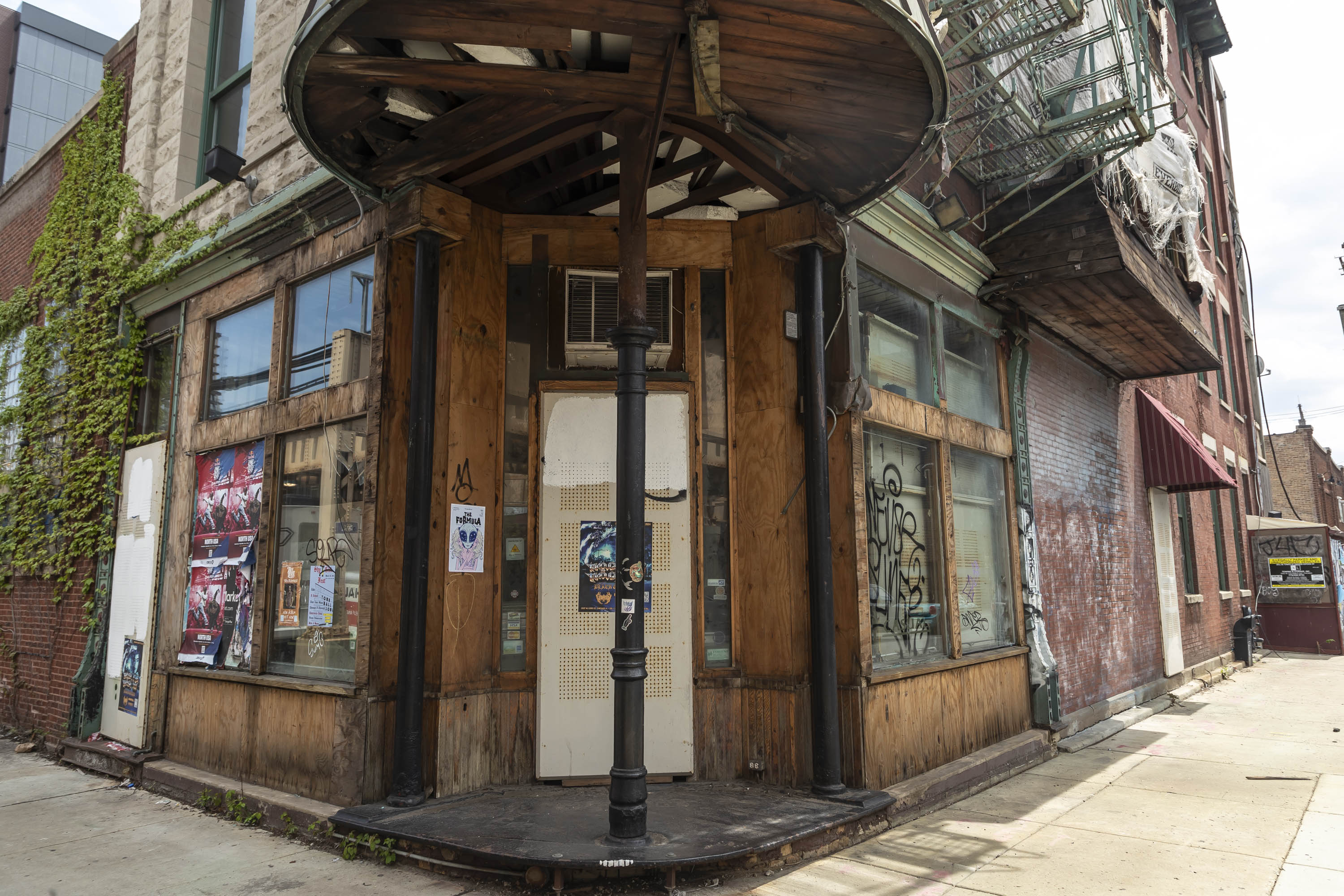In early June 2021, the city’s landmarks commission announced one of the big wins of the year for Chicago’s historical buildings. A four-story, Queen Anne-style building on Lake Street near Ogden — a charmer from 1892 with a copper turret on the corner and a three-story copper window bay on one side — was nominated as a city landmark just a few months after being saved from demolition. Then in July, the City Council voted unanimously to approve the landmarking.
On June 6, 2024, three years and three days after the building got landmark status, its owners are due in court. They face a foreclosure suit the city’s Law Department launched in January.
The building is “rapidly becoming dangerous,” city lawyers wrote in a February list of violations. You can see why when standing outside the building.
Much of the copper on the turret is gone, and some of what’s left looks like it could fall at any minute. So does the wood on the underside of the turret above the street-level entrance of what was until 2016 La Luce restaurant. Copper is also gone from the window bay on the west side along Loomis Street. A construction wrap that would have protected the exposed wood from rain is shredded and nearly gone. The wood looks saturated with water. The city’s report says water is also getting in below the roof, potentially damaging the brick and other materials.
Graffiti on walls and windows add to the impression this is an abandoned building.

This structure was in significantly better condition just a few years ago.
The building has been saved from demolition twice — not only in 2020 but also in 2016 — but now it appears headed for demolition by neglect.
The city requested a circuit court judge issue an injunction ordering the owner, Veritas LLC, to stabilize the building. Alternatively, the judge could declare the building abandoned and let the city take it over.
Tony Giannini, a Westchester real estate investor who is an owner of Veritas LLC, declined to comment.
So is this a preservation win? If the building was saved only to become an eyesore and a potential danger to people walking by, is that a win? What if it deteriorates to the point the owners or the city wind up with no choice but to tear it down?
If the structure is lost, one of the few remaining reminders of the old West Loop goes away. The neighborhood used to be an industrial, largely working-class area that is quickly being replaced by high-rise office and residential towers in the neighborhood’s building boom.
Also lost might be one of Chicago’s few remaining “tied houses,” a type of saloon from before Prohibition that served only one brand: its owner’s beer. In Chicago, the remaining tied houses were mostly related to Schlitz Brewing Company. Preservation Chicago and city officials described the Lake Street building as a tied house, though the owners disagreed.
There’s no Schlitz globe over the doorway, a symbol that clearly marks an old tied house at 94th Street and Ewing Avenue, as well as one at 69th and Morgan streets in Englewood, among others. But Preservation Chicago’s Ward Miller found a “ghost sign” with Schlitz’s script logo on a wall of the Lake Street building. The structure was completed in 1892 — a year before Schlitz started using the globe.
Whether it’s a tied house, we can’t write the former La Luce building off yet. It not only withstood two demolition attempts in the 21st century but also had a pretty sweet comeback a few decades before that.
In 1989, the building was just shy of its centennial when the restaurateurs in the Moretti family bought it.
Years later, Tom Moretti would say that “it was horrible around here” when they bought the building. The West Loop’s revitalization hadn’t begun, Chicago’s industrial base was in decline and “you’re talking about pimps, hookers, forklift trucks,” Moretti said. “It was insane.”
They gutted the interior of the main floor and fitted it out as La Luce, an old-style Italian restaurant. Online comments from 2004 described the interior as exposed brick, a tin ceiling, salvaged bits of old buildings and The Sopranos playing on the TV.
In 2016, La Luce closed after 27 years. Public records don’t make clear when the Morettis sold the building, but Veritas bought it in August 2020 for $1.75 million. Within a few months, the company applied for a demolition permit.
There was a two-day period that December when the building might have been lost. As Blair Kamin reported in the Chicago Tribune, the owners filed for a demolition permit with an incomplete address, which meant it didn’t get flagged for a delay that should have been triggered by the building’s “orange” status in the landmarks registry.

Orange means a building might have historical value and city officials need 90 days to check into it. Because of the incorrect address, the city issued a permit that it had to revoke two days later. Fortunately, demolition crews hadn’t rolled onto the site in the interim.
Instead, the building has sat decaying ever since.
Dennis Rodkin is the residential real estate reporter for Crain’s Chicago Business and Reset’s “What’s That Building?” contributor. Follow him @Dennis_Rodkin.
K’Von Jackson is the freelance photojournalist for Reset’s “What’s That Building?” Follow him @true_chicago.


